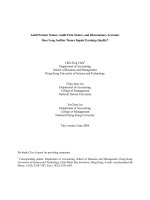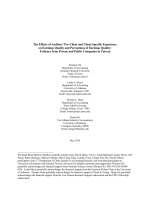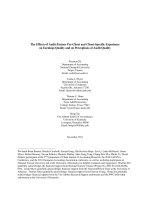daugherty et al - 2013 - mandatory audit partner rotation- perceptions of audit quality consequences [mapr]
Bạn đang xem bản rút gọn của tài liệu. Xem và tải ngay bản đầy đủ của tài liệu tại đây (173.65 KB, 6 trang )
Current Issues in Auditing American Accounting Association
Volume 7, Issue 1 DOI: 10.2308/ciia-50446
2013
Pages P30–P35
PRACTITIONER SUMMARY
Mandatory Audit Partner Rotation:
Perceptions of Audit Quality Consequences
Brian E. Daugherty, Denise Dickins, Richard C. Hatfield, and Julia L. Higgs
SUMMARY: This paper summarizes our study, ‘‘An Examination of Partner Perceptions
of Partner Rotation: Direct and Indirect Consequences to Audit Quality’’ (Daugherty et al.
2012). The study examines the perceptions of practicing audit partners with respect to
mandatory partner rotation and cooling-off periods, in general, and how the more
stringent partner rotation rules mandated by the Sarbanes-Oxley Act may negatively
impact audit partners’ quality of life at the expense of audit quality. The results suggest
that mandatory partner rotation increases partners’ (and other engagement team
members’) workloads, as well as the likelihood of partner relocation. In response to the
Sarbanes-Oxley Act and the SEC’s acceleration of mandatory partner rotation and
extension of cooling-off periods, the partners participating in this study indicate that they
would rather learn a new industry than relocate. Importantly, partners perceive that audit
quality suffers from retraining, but not from relocating. Taken toget her, the study’s results
suggest that the partner rotation provisions create an unintended consequence—
specifically an indirect, negative impact on audit quality.
Keywords: Sarbanes-Oxley; audit partner rotation; auditor independence; audit quality;
quality of life.
INTRODUCTION
In our paper ‘‘An Examination of Partner Perceptions of Partner Rotation: Direct and Indirect
Consequences to Audit Quality’’ ( Daugherty et al. 2012), we surveyed practicing audit partners to
examine their perceptions of mandatory audit partner rotation and cooling-off periods, and how the
accelerated rotation and extended cooling-off periods imposed by the Sarbanes-Oxley Act (SOX,
U.S. House of Representatives 2002) and the SEC may have impacted auditors’ quality of life and
Brian E. Daugherty is an Assistant Professor at University of Wisconsin–Milwaukee, Denise Dickins is an Assistant
Professor at East Carolina University, Richard C. Hatfield is a Professor at The University of Alabama, and Julia L.
Higgs is an Associate Professor at Florida Atlantic University.
Submitted: January 2013
Accepted: February 2013
Published Online: March 2013
audit quality. SOX accelerated lead audit partner rotation on U.S. public company audits from
seven to five years. Further, SOX extended mandatory rotation to the engagement quality review
partner. The SEC extended the mandatory cooling-off period before the lead and engagement
quality review partners could return to the engagement from two to five years SEC (2003).
1
These
legislative and regulatory changes led us to survey audit partners who practiced in both the pre-
and post-SOX eras about their perceptions concerning mandatory rotation. We specifically
consider how partner rotation, including SOX-mandated changes, may influence partners’
perceived quality of life and how they manage potential trade-offs between quality of life and
audit quality.
Mandatory partner rotation enables auditors to take a fresh look at client risk and engagement
issues and, therefore, is viewed as increasing auditor independence, albeit at the expense of lost
institutional knowledge related to client-specific matters. In the late 2000s, the U.S. Department of
the Treasury’s Advisory Committee on the Auditing Profession (ACAP) heard testimony on partner
rotation, including arguments that the SOX-imposed partner rotation revisions negatively impacted
partners’ quality of life and, in turn, was detrimental to overall audit quality (U.S. Department of the
Treasury, ACAP 2008). Some of the testimony documented difficulties with reassignments caused
by more frequent partner rotation, particularly in remote geographic regions and in small-practice
offices; a growing concern about the profession’s ability to attract and retain high-caliber partners;
and detrimental effects on technical and sector experience that results in diminished audit quality.
To determine whether these concerns are warranted, we distributed a survey to 370 practicing
audit partners at 14 firms, representing approximately 40 distinct practice-office locations of
various sizes. One hundred seventy surveys were returned (a 46 percent response rate) from Big 4
firm partners (22 percent), midsize-firm partners (50 percent), and smaller-firm partners (28
percent). All responding partners had public company audit experience with firms subject to
mandatory audit partner rotation. We developed the survey by conducting in-depth, semi-
structured interviews with seven practicing audit partners in various geographic locations and
practice-office sizes. We conducted these interviews to better understand the current rotation
environment and how the SOX revisions were affecting practicing audit partners. Six of the
interviewees were office managing partners and one was an industry expert partner. We chose this
industry expert to assist in the development of the field survey to better understand the role of
industry expertise on audit quality. Following the interviews, we developed a model (Figure 1) of
the direct and indirect effects of mandatory rotation on audit quality, formed a series of related
hypotheses, and developed the survey to test the model. The survey results were consistent with
the various hypotheses, and thus consistent with the model.
The model predicted that partner rotation has a direct and negative effect on client-specific
knowledge, and that client-specific knowledge has a direct and positive effect on audit quality. The
model also predicts that partner rotation has a direct and positive effect on both auditor
independence and audit quality. With respect to indirect effects, the model suggests that partner
rotation influences partners’ perceived quality of life with four primary potential reactions—relo-
cation, retraining, resignation, and/or extensive commuting. These reactions were posited to have
differential influences on audit quality.
1
The lead partner on subsidiaries of a registrant whose assets or revenues constitute 20 percent or more of
consolidated assets or revenues also is subject to the new requirements. However, partners who consult with
the engagement team regarding technical or industry-specific issues are not subject to the requirements (SEC
2003).
Daugherty, Dickins, Hatfield, and Higgs P31
Current Issues in Auditing
Volume 7, Issue 1, 2013
FINDINGS
Participants were predominantly male (80 percent) and 90 percent were married. The audit
partners reported being an expert in an average of 2.6 industries, and had been lead (engagement
quality review) partner on an average of 1.7 (1.8) public company audits in the prece ding year.
They averaged 47 years old, and had been an audit partner for an average of 11 years. We viewed
partner tenure as critical to the validity of our findings. At the time that we distributed the survey,
SOX had been enacted for approximately seven years, and the revised partner rotation
requirements had been in place for approximately five years. Thus, the majority of our audit partner
participants had practiced in both the pre- and post-SOX environments, providing relevant
experience on which to base their perceptions.
Our participants reported being employed in practice locations averaging 11 audit partners,
with one-third reporting five or fewer audit partners, and two-thirds reporting eight or fewer audit
partners. We believe that this further contributes to the validity of our findings given that much of
the ACAP testimony suggested that the SOX revisions to partner rotation were particularly difficult
for smaller firms and for smaller-practice locations. The following subsections describe our findings
related to the direct and indirect effects of mandatory partner rotation, including the changes
mandated by the SOX legislation.
2
FIGURE 1
Model of Direct and Indirect Effects of Mandatory Rotation on Audit Quality
2
All findings discussed are significant at traditional statistical levels unless otherwise indicated. Statistical
significance levels are calculated by comparing means to the midpoint of a seven-point Likert scale, a
meaningful midpoint separating general agreement from disagreement with the various statements included in
the survey.
Daugherty, Dickins, Hatfield, and Higgs P32
Current Issues in Auditing
Volume 7, Issue 1, 2013
Direct Effects of Rotation on Audit Quality
Surveyed partners view mandatory rotation, in general, as improving auditor independence
both in fact, relating to the auditor’s independent mental attitude, and in appearance, relating to
others’ perceptions of auditor independence, which in turn results in a positive impact on audit
quality. However, our participating partners also agree that client-specific knowledge is lost
because of rotation (reducing audit quality), and that longer auditor tenures yield higher audit
quality. As one partner noted, ‘‘audit quality can be negat ively impacted when a key member of the
engagement team, who has gained special knowledge of a client, is removed from the team’’
(Daugherty et al. 2012).
The partners do not view the acceleration of rotation, or extension of cooling-off periods,
required by SOX and the implementing SEC rules as improving auditor independence in fact.
Accelerated rotation is perceived to enhance independence in appearance, but extended cooling-
off periods have no significant effect on perceived independence.
Effects of Rotation on Partners’ Perceived Quality of Life
With regard to mandatory partner rotation, in general, participating partners believe that
rotation increases the workload of the incoming lead partner, the outgoing lead partner, and other
engagement team members in the initial year of rotation. They also perceive that mandatory
rotation increases the likelihood of being required to relocate during their career, and that the
potential for relocating (or extensive commuting) discourages employees from pursuing an audit
partner track career progression. The partners collectively believe that required relocation
negatively impacts their quality of life (e.g., spouse career disruption, children changing schools).
With respect to the SOX and SEC implemented rules accelerating rotation and extending
cooling-off periods, surveyed partners believe that these changes significantly increase the
likelihood that they will be required to gain new industry expertise over the course of their careers.
They do not believe that the new changes hinder their ability to attract high-caliber employees, but
they are neutral on the impact of the changes on their ability to retain these types of employees.
Notably, while the partners indicate that mandatory rotation (in general) increases the likelihood of
relocation, the partners do not believe that accelerated rotation and extended cooling-off periods
increase the frequency with which they will have to relocate. It appears that the reconciliation of
these differing perceptions lies in the partners’ reported behavioral responses to relocation.
Partners’ Behavioral Responses to Relocation
As discussed, relocation caused by mandatory partner rotation is viewed as having a negative
and significant impact on partners’ quality of life. Similar results are found for partners’ perceptions
about serving less-prestigious clients. On average, partners are more willing to invest time gaining
new industry expertise than to relocate in response to accelerated rotation and increased cooling-
off periods. Surveyed partners’ other responses bear out these findings as less than four percent
had relocated as a result of mandatory partner rotation, while just over half report having learned a
new industry as a result of rotation requirements.
3
3
Our survey was administered after the first round of mandatory partner rotations under the new requirements.
These percentages may well change following the second and succeeding rounds of partner rotations.
Daugherty, Dickins, Hatfield, and Higgs P33
Current Issues in Auditing
Volume 7, Issue 1, 2013
Effect of Relocating versus Retraining on Audit Quality
The participating partners disagree that audit quality suffers as a result of required relocation,
but agree that audit quality is diminished when engagement partners acqui re new industry
expertise. One partner stated, ‘‘My biggest issue with the current rotation issue relates to the need
to completely learn a new industry and clients to which we have little familiarity and industry
knowledge’’ (Daugherty et al. 2012). Given that the surveyed partners appear to avoid relocation
out of concern for quality of life, and more than 50 percent report learning a new industry to remain
in their current practice location, these fi ndings collect ively suggest that an unint ended
consequence of the SOX rotation mandates may be diminished audit quality—at least in the
near term.
Partners report that it takes an average of 2.5 years to become fully effective on a new audit
assignment (58 percent reported needing more than two years, and 93 percent reporting needing
at least two years). These findings are consistent with the results of prior research that suggest a
two-to-three year familiarization period in the pre-SOX era (e.g., Johnson et al. 2002). In written
responses accompanying the survey, some partners suggested that the departing engagement
partner’s effectiveness also may be somewhat diminished in their final year on an audit
engagement as they are ‘‘auditioning’’ for their replacement engagement(s) with audit committees,
senior management, etc. If true, this suggests that engagement partners only may be optimally
effective during their third and fourth years of a five-year audit engagement tenure. This impact
may be further compounded by the extended cooling-off period before a partner may return to the
client, a time during which substantial institutional changes at the client are likely to occur (e.g.,
turnover of audit committee members and senior management, new information and risk
management technologies).
PRACTICE IMPLICATIONS AND SUGGESTIONS
FOR FUTURE RESEARCH
Our survey provides evidence that unintended consequences of new regulations may occur
because of strategic partner responses in a dynamic environment. That is, partners have a need
for work/life balance and maintaining this balance, in this instance, may have implications for the
expectation of improved audit quality brought about by SOX. Under the current rotation
requirements, these findings suggest that knowledge transfer strategies between audit partners
and other members of the audit engagement team are critical. As one partner noted, ‘‘Coordination
of outgoing, incoming partners is critical and time consuming and ultimately, is in the hands of
those two partners’’ (Daugherty et al. 2012). A detailed discussion of examples of knowledge
transfer strategies can be found in Daugherty et al. (2011). Further, audit firms need to have a
robust succession-planning program so that partners have adequate time to retool in a new
industry.
When we conducted interviews in late 2009 to help better understand the range of issues
potentially created by SOX- and SEC-mandated changes to the audit partner rotation rules, one of
the partners suggested that, at that time, we would likely only be seeing the ‘‘tip of the iceberg’’ with
respect to the changes’ full impact on partners’ quality of life and audit quality. As we are now
beyond the tenth anniversary of SOX and additional rounds of rotations under the revised
requirements, this observation and our findings suggest a number of opportunities for additional
research, both domestically and internationally. In particular, researchers may want to examine
evidence of post-SOX changes in audit and financial reporting quality. Rotation regimes vary from
Daugherty, Dickins, Hatfield, and Higgs P34
Current Issues in Auditing
Volume 7, Issue 1, 2013
country to country, and a number of countries have revised their mandatory audit partner rotation
requirements. For example, Canada adopted SOX-like partner rotation requirements in 2004, but
reverted to a seven-year-on, five-year-off policy in 2010. It may be helpful to compare audit quality
across regimes in an attempt to isolate the impact of differences in partner rotation requirements
on auditors’ quality of life, audit quality, financial reporting quality, and client satisfaction.
Further, some jurisdictions, such as Australia, require audit partners to personally sign the
audit report, thus allowing researchers to identify when rotation occurs and to measure the
associated costs and benefits. In 2011, the Public Company Accounting Oversight Board
(PCAOB) proposed amendments to existing auditing standards (PCAOB Release No. 2011-007)
that would, among other matters, require registered accounting firms to disclose the name of the
engagement partner in the audit opinion (PCAOB 2011), which would open up similar research
opportunities in the U.S. if this proposal were adopted. There is some evidence that at least certain
market participants, in particula r audit committee members, view the changes to audit partner
rotation as having improved auditor independence, financial reporting quality, and auditors’ ability
to detect financial statement fraud (Dickins et al. 2012).
Future research can provide feedback on the effectiveness of the post-SOX changes in
financial reporting and audit quality. The U.S. auditing practice might be well served in modifying
rotation and coolin g-off periods, similar to Canada’s reversion, to extract the benefits of rotation
while reducing some of the unintended consequences identified in this research.
REFERENCES
Daugherty, B. E., D. Dickins, R. C. Hatfield, and J. L. Higgs. 2012. An examination of partner perceptions of partner
rotation: Direct and indirect consequences to audit quality. Auditing: A Journal of Practice & Theory 31 (1): 97–
114.
Daugherty, B., D. Dicki ns, and J. Higgs. 2011. Reducing the potential negative effects of mandatory partner rotation.
CPA Journal 81 (8): 60–63.
Dickins, D., B. Daugherty, and J. Higgs. 2012. Do audit committee members care about engagement partner rotation?
Today’s CPA 39 (4): 42–43.
Johnson, V. E., I. K. Khurana, and J. K. Reynolds. 2002. Audit-firm tenure and the quality of financial reports.
Contemporary Accounting Research 19: 637–660.
Public Company Accounting Oversight Board (PCAOB). 2011. Improving the Transparency of Audits: Proposed
Amendments to PCAOB Auditing Standa rds and Form 2. Release No. 2011-007. Available at: http://pcaobus.
org/Rules/Rulemaking/Docket029/PCAOB_Release_2011-007.pdf
Securities and Exchange Commission (SEC). 2003. Commission Adopts Rules Strengthening Auditor Independence.
Release No. 2003-09. Available at: />U.S. Department of the Treasury Advisory Com mittee on the Auditing Profession (ACAP). 2008. Meeting minutes,
February 4. Available at: />2-4-08.pdf
U.S. House of Representatives. 2002. The Sarbanes-Oxley Act of 2002. Public Law 107-204 [H.R. 3763].
Washington, DC: Government Print ing Office.
Daugherty, Dickins, Hatfield, and Higgs P35
Current Issues in Auditing
Volume 7, Issue 1, 2013



![chi et al - 2005 - mandatory audit-partner rotation, audit quality and market perception - evidence from taiwan [mapr]](https://media.store123doc.com/images/document/2015_01/06/medium_pap1420548067.jpg)
![chi et al - 2009 - mandatory audit partner rotation, audit quality, and market perception - evidence from taiwan [mapr]](https://media.store123doc.com/images/document/2015_01/06/medium_brl1420548068.jpg)


![al-thuneibat et al - 2011 - do audit tenure and firm size contribute to audit quality - empirical evidence from jordan [at]](https://media.store123doc.com/images/document/2015_01/06/medium_uqu1420548079.jpg)
![arel et al - 2005 - audit firm rotation and audit quality [mafr]](https://media.store123doc.com/images/document/2015_01/06/medium_bqa1420548082.jpg)
![bamber and bamber - 2009 - discussion of mandatory audit partner rotation, audit quality, and market perception - evidence from taiwan [mapr]](https://media.store123doc.com/images/document/2015_01/06/medium_npc1420548084.jpg)